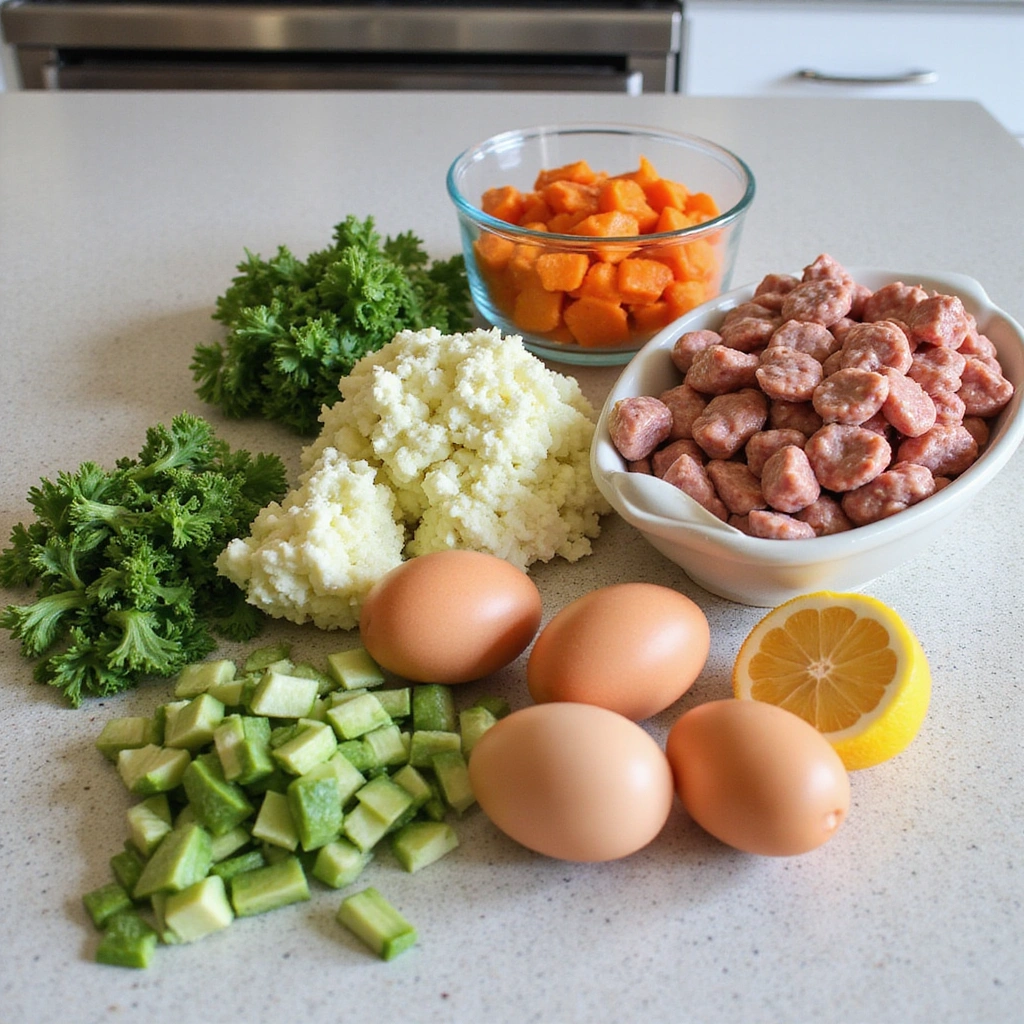Pork sausage breakfast recipes are a beloved morning staple that offer a savory start to your day.
The rich, juicy flavor of the sausage combined with eggs and other breakfast favorites creates a symphony of tastes that is hard to resist.
I grew up enjoying hearty breakfasts featuring pork sausage, where the aroma would fill the kitchen and entice everyone to gather around the table.
Whether you’re cooking for a family brunch or a weekend treat, these savory morning classics will impress and satisfy with their comforting essence.
The History and Cultural Significance
• Pork sausage breakfast recipes have their origins in Europe, particularly in countries like Germany and Italy, where sausage-making was a craft passed down through generations.
• The dish evolved over the years as various cultures incorporated local spices and herbs, leading to unique regional flavors that are still celebrated today.
• In the United States, pork sausage breakfast dishes are often enjoyed on weekends and holidays, symbolizing a time for family gatherings and shared meals.
• While many variations exist, the authentic version often includes simple, high-quality ingredients that highlight the savory taste of the pork.
Recipe Overview
Nutritional Information (per serving)
Ingredients
Essential Equipment Guide
Cast Iron Skillet: This heavy-duty skillet is essential for achieving a perfect sear on the sausage. It retains heat well and distributes it evenly, making it ideal for browning meat. Look for a pre-seasoned option to maximize flavor and prevent sticking.
Mixing Bowl: A large mixing bowl is necessary for combining ingredients, especially if you’re making your own sausage blend. Choose a bowl with a non-slip base for stability while mixing.
Meat Thermometer: To ensure your sausage is cooked to the proper temperature, a meat thermometer is crucial. Opt for a digital model for quick and accurate readings.
Preparation Methods
Chopping: This technique is important for ensuring even cooking of your vegetables. Use a sharp knife to dice your bell pepper and onion into uniform pieces. This allows for consistent texture and flavor in each bite.
Searing: Searing the sausage before cooking through adds depth of flavor. Use medium-high heat to achieve a nice brown crust, which enhances the overall taste of the dish.
Scrambling: For fluffy scrambled eggs, whisk them vigorously before cooking. This incorporates air, resulting in a light texture. Cook over low heat to prevent overcooking and achieve a creamy consistency.
Step 1: Prepare Ingredients

Begin by gathering all your ingredients on the countertop.
Ensure they are at room temperature for best results.
Chop the bell pepper and onion into small, even pieces.
This will help them cook uniformly in the skillet.
Step 2: Cook the Sausage

Heat a cast iron skillet over medium-high heat.
Add the pork sausage, breaking it apart with a spatula as it cooks.
Cook until browned and cooked through, about 7-10 minutes.
Make sure there are no pink spots left to ensure the sausage is safe to eat.
Step 3: Sauté the Vegetables

Once the sausage is cooked, remove it from the skillet and set aside.
In the same skillet, add the diced bell pepper and onion.
Sauté for about 5 minutes until they are soft and fragrant.
This will infuse the skillet with flavor from the sausage drippings.
Step 4: Scramble the Eggs

In a mixing bowl, crack the eggs and whisk them together with a pinch of salt and pepper.
Pour the egg mixture into the skillet with the sautéed vegetables.
Stir gently with a spatula as they begin to set, about 3-4 minutes.
Remove from heat when they are just cooked but still soft.
Step 5: Combine and Serve

Add the cooked sausage back into the skillet with the eggs and vegetables.
Gently fold everything together to combine.
Taste and adjust seasoning if necessary.
Serve immediately, garnished with fresh parsley.
Step 6: Enjoy Your Breakfast

Take a moment to appreciate the aroma and colors of your dish.
Serve it hot with toast or your choice of sides.
Invite family or friends to join you for a delightful breakfast experience.
Remember, this dish is best enjoyed fresh and warm.
Critical Timing and Temperature Guide
Cooking Sausage: Cook the sausage for about 7-10 minutes until browned and internal temperature reaches 160°F. Look for a golden brown color and no pink in the center. Avoid overcooking to prevent dryness.
Sautéing Vegetables: Sauté for 5 minutes until vegetables are soft and slightly caramelized. They should be tender but still maintain their shape. Avoid burning by adjusting the heat if necessary.
Scrambling Eggs: Cook the eggs for 3-4 minutes on low heat until just set. Stir gently to maintain a fluffy texture. Avoid high heat to prevent rubbery eggs.
Pro Tips for Pork Sausage Breakfast Recipes Savory Morning Classics
• Ingredient Selection: Choosing high-quality pork sausage makes a significant difference in flavor. Look for sausage made from fresh pork with minimal fillers.
• Preparation Secret: Allowing sausage to rest for a few minutes after cooking helps retain juices, enhancing flavor and moisture.
• Temperature Management: Bringing eggs to room temperature before cooking can lead to fluffier scrambled eggs.
• Texture Enhancement: For ideal texture, avoid over-stirring the scrambled eggs; let them cook gently.
• Flavor Layering: Incorporate herbs like thyme or rosemary into the sausage mix for added depth.
• Make-Ahead Strategies: Cook the sausage and vegetables in advance, then reheat them when ready to scramble the eggs for a quick breakfast.
• Restaurant-Quality Finishing Touches: Drizzle a bit of olive oil or a sprinkle of cheese right before serving to elevate the dish.
• Equipment Optimization: Use non-stick pans for the eggs to prevent sticking and ensure easy cleanup.
Troubleshooting Common Issues
• Sausage Too Greasy: If your sausage turns out greasy, it may be due to cooking at too low a temperature. Ensure your skillet is preheated to medium-high before adding sausage.
• Scrambled Eggs Too Dry: If your scrambled eggs are dry, they may have been cooked too long. Cook over low heat and remove from heat when they are still slightly runny.
• Vegetables Burned: If vegetables burn, it’s likely due to high heat. Lower the heat and add a bit of water to help them cook without burning.
• Flavor Lacking: If the dish tastes bland, consider adjusting the seasoning. Always taste as you cook to ensure proper flavor balance.
• Texture Off: If your sausage is tough, it may have been overcooked. Monitor cooking times carefully to maintain juiciness.
• Eggs Not Fluffy: If eggs aren’t fluffy, be sure to whisk them thoroughly before cooking and use low heat.
Variations and Regional Differences
• Southern Style: In the South, breakfast sausage often includes sage and is served with biscuits and gravy, adding a rich and hearty element to the dish.
• Italian Sausage Breakfast: Italian breakfast sausage is seasoned with fennel and garlic, offering a different flavor profile that pairs beautifully with eggs and peppers.
• Chorizo Breakfast Tacos: In Mexico, chorizo is a popular alternative to traditional sausage, often served in tacos with scrambled eggs and avocado.
• Modern Interpretations: Today, many chefs experiment with plant-based sausages, offering a vegetarian alternative that maintains the savory essence of the dish.
Food Science Behind the Recipe
• Maillard Reaction: This chemical reaction occurs when proteins and sugars in the sausage brown during cooking, creating a rich flavor and appealing color. Understanding this helps achieve that perfect golden-brown exterior.
• Emulsification: The process of combining fat and water in sausage helps create a juicy, flavorful product. Knowing how to properly mix ingredients ensures the fat is evenly distributed.
• Gelatinization: When cooking eggs, the proteins undergo gelatinization, which is crucial for achieving the desired texture. Cooking eggs slowly allows for a creamy outcome.
Frequently Asked Questions
What’s the most common mistake people make when preparing pork sausage breakfast recipes? The most common mistake is cooking sausage at too low a temperature, which can lead to greasy results. Always ensure your skillet is preheated adequately.
Can I prepare components of this dish in advance? Yes, you can cook the sausage and sauté the vegetables ahead of time. Store them in the refrigerator for up to 3 days and reheat when ready to serve.
How do I adapt this recipe for dietary restrictions? For gluten-free options, ensure your sausage is gluten-free and use gluten-free bread if serving with toast. You can also substitute eggs for tofu for a vegan option.
What’s the best way to store and reheat leftovers? Store leftovers in an airtight container in the fridge for up to 3 days. Reheat in a skillet over medium heat until warmed through.
Can I freeze this dish? Yes, both the sausage and scrambled eggs can be frozen. Store in airtight containers for up to 2 months. Thaw overnight in the fridge and reheat gently.
What wine or beverages pair best with this dish? A light-bodied white wine or a mimosa pairs well with the savory flavors of the dish. Coffee is also a classic breakfast beverage choice.
How can I scale this recipe up for a crowd? Simply multiply the ingredients by the number of servings needed, but keep in mind to use larger cooking vessels and adjust cooking times as necessary.
What side dishes complement this recipe best? Fresh fruit, hash browns, or a light salad make great accompaniments, balancing the richness of the sausage and eggs.
How do professional chefs elevate this dish for restaurant service? They often incorporate gourmet ingredients like truffle oil in the eggs or offer artisanal sausage options to enhance flavor and presentation.
Serving and Presentation Guide
• Traditional Presentation: Serve the dish on a large platter with the sausage and eggs arranged attractively. Garnish with fresh herbs for color.
• Modern Plating Ideas: Use individual plates for each serving, adding a drizzle of sauce or a sprinkle of microgreens for a contemporary touch.
• Accompaniment Suggestions: Serve with crusty bread or homemade biscuits to soak up the flavors, along with fresh fruit for a refreshing contrast.
• Special Occasion Presentation: For brunch gatherings, consider using elegant serving bowls for the eggs and sausage, adding a side of hollandaise sauce for an upscale touch.
Conclusion
I encourage you to try this savory pork sausage breakfast recipe for your next morning meal.
The delightful combination of flavors and textures will surely become a favorite in your household.
Sharing this dish with loved ones is a wonderful way to create lasting memories around the breakfast table.






